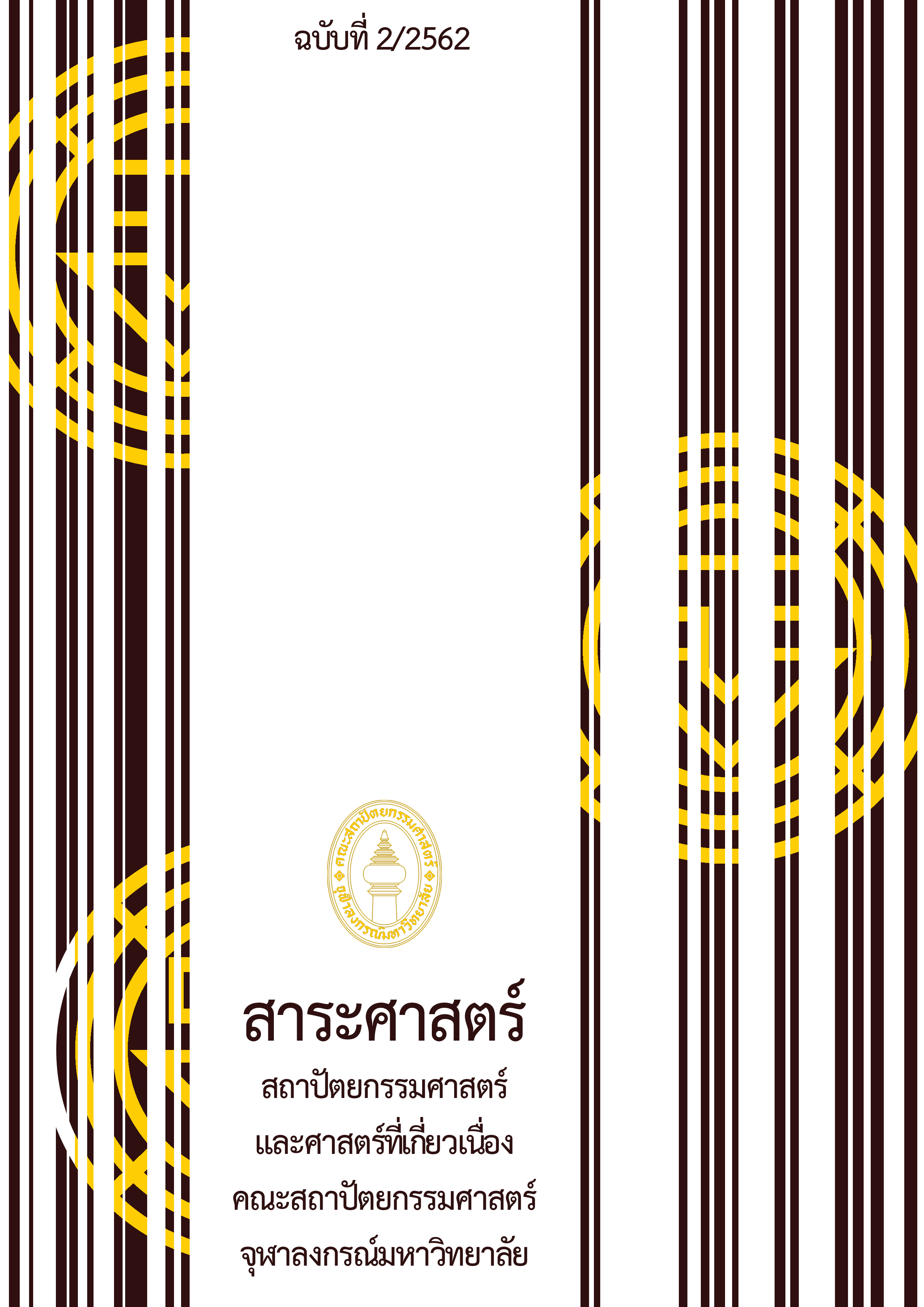Scope of Work for Construction Supervision in Government Project
Main Article Content
Abstract
Since 2018, scope of work for construction supervisor when dealing with public sector building is based on Government Procurement and Supplies Management Act B.E 2560 (2017) which has been adjusted from Regulations of the Office of the Prime Minister on Procurement B.E.2535 (1992). The change in regulations led to a shift in professional service fees and details of work according to TOR (Terms of References). Taken interested in the changes, this research aims to conduct a comparative study between the previous TOR in 2003 and the new TOR in 2017 in order to conclude all the changes within scope of work. Research methodologies include 1) a study and literature review related to regulations for hiring construction supervisors and scope of their works 2) a comparative study between TORs in the case study, including three buildings under the regulation on procurement in 1992 and three buildings under regulation on procurement in 2017, 3) results and analytical data.
By comparing the two regulations, the research found that there’s a clause, stating about how scope of work for construction supervisors might exceed from the regulation on procurement. In addition scope of work for construction supervisors in 2017 has more roles added in the regulations compared with that of 1992. The additional roles include 1) information for personnel, 2) regulation in executing the projects and managing tools, and 3) additional costs for construction supervisors, such as software fees, rental fees of the temporary sites, equipment fees, and fees for printed documents regarding building certification during process of handling the buildings.
The result pointed out that by increasing professional service fees up to what’s written in the newly-issued law, the development of project management and construction processes have been more delicate and corresponded to the number of personnel that were qualified in terms of their working experiences according to TOR in each project. Moreover, the larger project building which used 2017’s TOR began to utilize Building Information Modeling, or BIM as a mean to manage the projects and reduce unexpected mistakes thanks to the fact that BIM simulated all of the construction processes before the real work began. Therefore, the increase in professional service fees will affect the management of the construction process in the foreseeable future. The supervisors should introduce appropriate tools to help processes of managing projects become more precise and effect, thus reducing errors in construction processes.
Article Details
References
คณะกรรมการสาขาวิศวกรรมโยธา. ขอบเขตและหน้าที่การให้บริการวิชาชีพการบริหารงานก่อสร้าง. พิมพ์ครั้งที่ 4. กรุงเทพมหานคร: วิศวกรรมสถานแห่งประเทศไทย ในพระบรมราชูปถัมภ์, 2559.
คณะอนุกรรมการกิจการพิเศษสภาวิศวกรรม. “หลักเกณฑ์การจัดทำขอบเขตงาน (Terms of Reference :TOR)การจ้าง ออกแบบหรือควบคุมงานก่อสร้าง.” งานสัมมนาเรื่อง ค่าใบอนุญาตวิชาชีพ ขอบเขตของงานจ้าง (TOR) ที่ปรึกษาและ ออกแบบคุมงาน, ณ สภาวิศวกร กรุงเทพมหานคร, 4 ตุลาคม 2561.
ไตรวัฒน์ วิรยศิริ. การจัดการสถาปัตยกรรม. กรุงเทพมหานคร: โรงพิมพ์จุฬาลงกรณ์มหาวิทยาลัย, 2558.
“พระราชบัญญัติการจัดซื้อจัดจ้างและการบริหารพัสดุภาครัฐ พ.ศ. 2560.” ราชกิจจานุเบกษา.เล่ม 134 ตอนที่ 24 ก หน้า 39. (2560, 25 กุมภาพันธ์).
“ระเบียบกระทรวงการคลัง ว่าด้วยการจัดซื้อจัดจ้างและบริหารพัสดุภาครัฐ พ.ศ. 2560.” ราชกิจจานุเบกษา.เล่ม 134 ตอนพิเศษ 210 ง หน้า 31-41. (2560, 23 สิงหาคม).
ลานนา ตระการเถลิงศักดิ์. “แนวทางการปรับปรุงข้องกำหนดโครงการ (TOR : Terms of Reference)ของผู้ควบคุมงานก่อสร้าง กรณีศึกษา โครงการก่อสร้างอาคารเพื่อการศึกษา สถาบันอุดมศึกษาของภาครัฐ.” วิทยานิพนธ์ปริญญามหาบัณฑิต สาขาสถาปัตยกรรม คณะสถาปัตยกรรมศาสตร์ จุฬาลงกรณ์มหาวิทยาลัย, 2555.
ศานิต กี่บุตร. “รูปแบบการจ้างที่ปรึกษาบริหารโครงการและจ้างควบคุมงานก่อสร้าง ภาครัฐ.” วิทยานิพนธ์ปริญญามหาบัณฑิต สาขาสถาปัตยกรรม คณะสถาปัตยกรรมศาสตร์ จุฬาลงกรณ์มหาวิทยาลัย, 2556.


